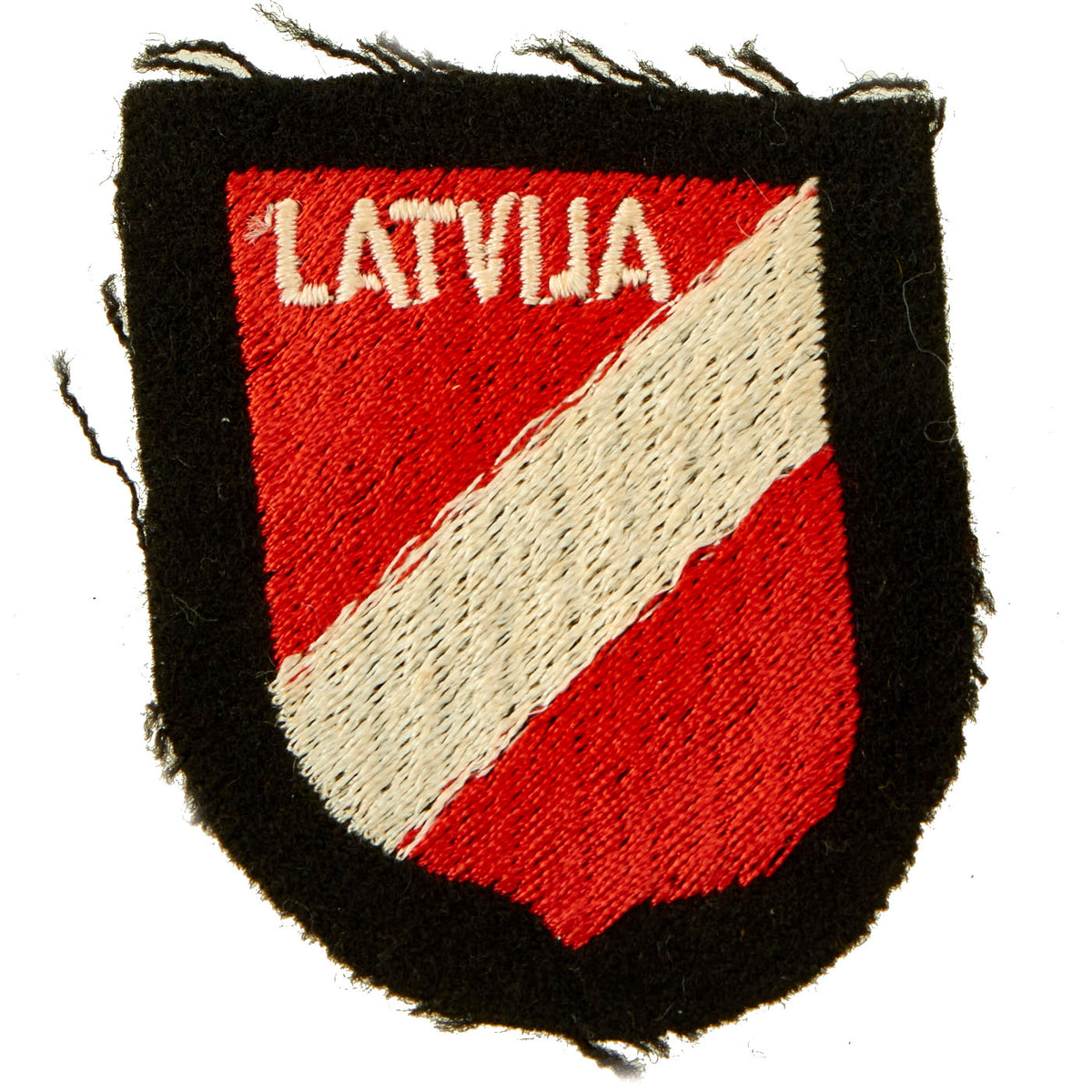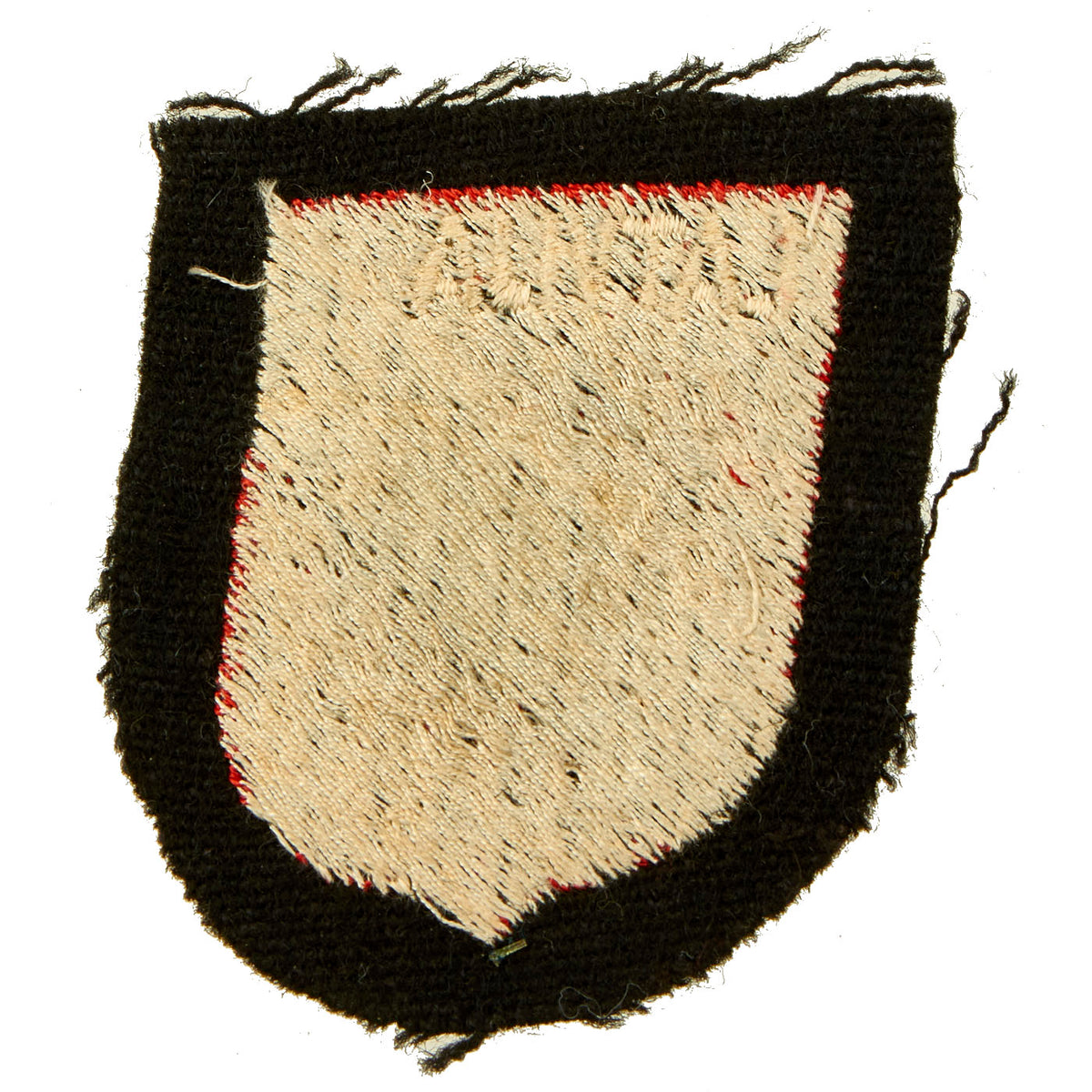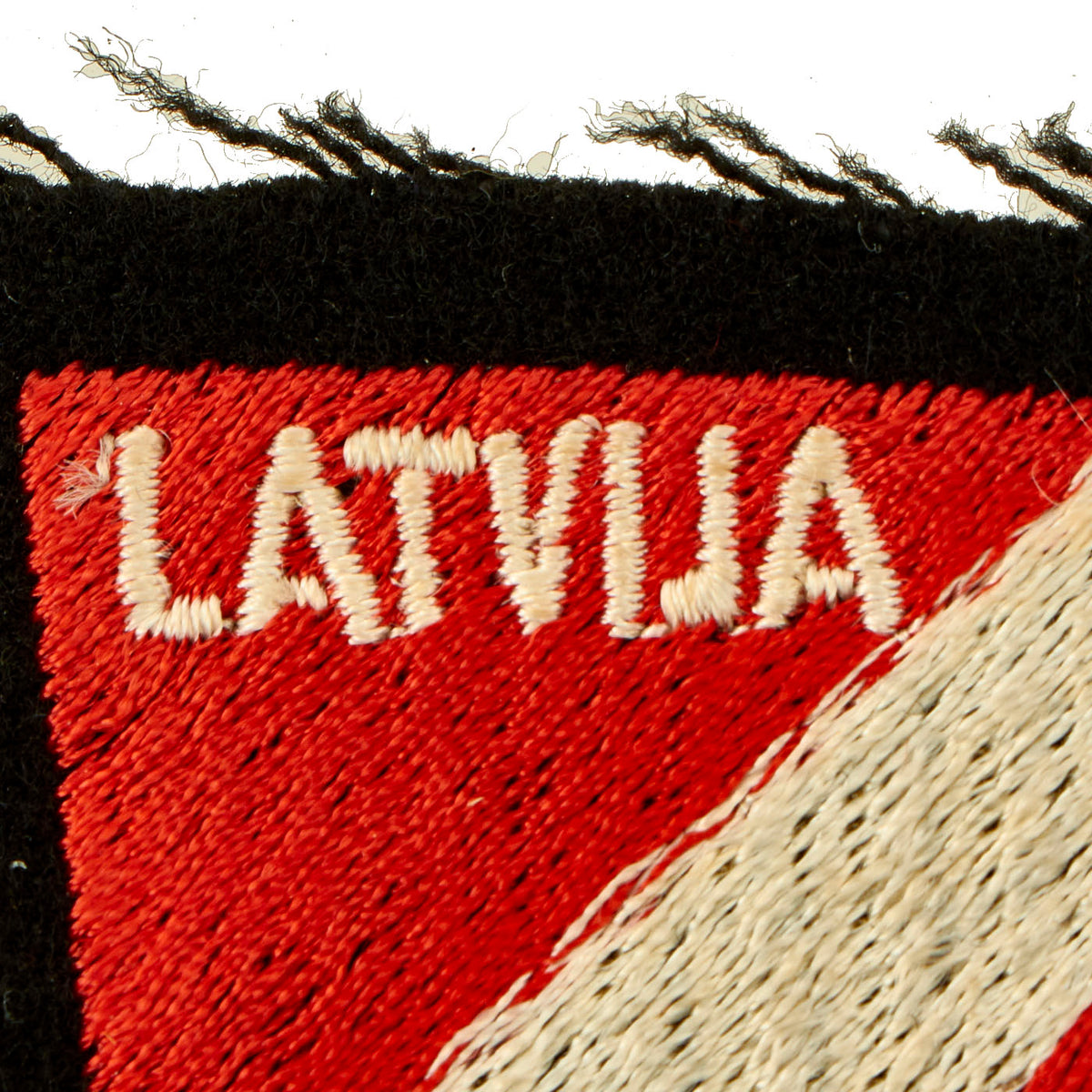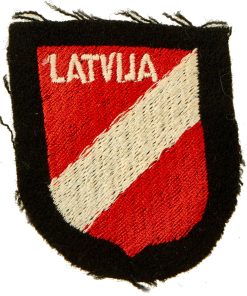Original German WWII Embroidered Waffen SS Latvian Volunteer Shield Sleeve Insignia Original Items
$ 125,00 $ 50,00
Original Item: Only One Available. This is a textbook example of WWII German Lettische Freiwillige Waffen SS Ärmelabzeichen (Latvian Volunteer Waffen SS sleeve insignia). It is constructed of red and white machine embroidery, with LATVIJA embroidered in white uppercase lettering on the top left of the shield. The insignia measures approximately 2 1/2″ x 2 1/8″, and is embroidered onto black “Badge cloth. These were usually sewn to the sleeve of the uniform.
We have heard that many of these were made at the Dachau camp, and many unissued examples were recovered at the end of the war when the camp was liberated. There is however no concrete evidence regarding this.
The insignia is in excellent condition, most likely unissued, and was never attached to a uniform. Ready to add to your collection!
The Latvian Legion (Latvian: Latviešu leģions) was a formation of the German Waffen-SS during World War II. Created in 1943, it consisted primarily of ethnic Latvian personnel. The 15th Division was administratively subordinated to the VI SS Corps, but operationally it was in reserve or at the disposal of the XXXXIII Army Corps, 16th Army, Army Group North. The 19th Division held out in the Courland Pocket until May 1945, the close of World War II, when it was among the last of NSDAP Germany’s forces to surrender.
The legion consisted of two divisions of the Waffen-SS: the 15th Waffen Grenadier Division of the SS (1st Latvian), and the 19th Waffen Grenadier Division of the SS (2nd Latvian).
Operational history
The first Latvian Legion unit was the 2nd Latvian SS Brigade, created in February 1943. It fought its first battle in the Siege of Leningrad, opposite the Pulkovo observatory on 18 March 1943. It continued fighting around Leningrad until the German forces retreated in January 1944.
The 15th Waffen-SS Division was formed and sent to the front in November 1943. Originally, it was sent to the Ostrov and Novosokolniki districts of Pskov Oblast, but after the German Army suffered setbacks there, was moved to positions in the Belebelka district of Novgorod Oblast in January 1944. It retreated from there a month later. At the end of February 1944, both units took joint defensive positions on the Sorota and Velikaya rivers. At that time, the 2nd Brigade was renamed the 19th Waffen-SS division. Over the next two months, these positions saw intense fighting.
In April 1944, the Legion was replaced by other units and moved to less active positions in Bardovo-Kudever, 50 km east of Opochka. It came under attack there in June 1944 and started to retreat on July 10, 1944, crossing the Latvian-Russian border on July 17.
In August and September 1944, the 15th Division was moved to Prussia, for replenishment with new recruits. It was in training near Danzig until being ordered into battle on 22 January 1945. At that time, the division consisted of about 15,000 soldiers. It fought near Danzig in January and February, retreating to Pomerania in early March. By early April, the division was reduced to 8,000 men. About 1,000 were sent by sea to replenish the forces in the Courland Pocket, the rest were lost during the fighting. On April 11, the division was told about plans to transfer the entire division to Courland. Seeing that the war was lost and understanding that being sent to Courland would mean eventually having to surrender to the Soviets, the division decided to surrender to the Western Allies instead, disobeying German orders to the contrary, when necessary.
The 19th Division continued to fight in Latvia. In October 1944, Soviet advances in Lithuania cut off it and other units in the Courland Pocket from the rest of the German forces. It was a part of the six battles between Soviet and German armies in the Courland Pocket in 1944 and 1945. During the third battle in December 1944, the opposing Soviet units included two Latvian divisions, the 43rd and the 308th, formed from recruits drafted in Soviet-occupied Eastern Latvia. When the Latvian units on both sides of the front faced one another, they were quite unwilling and occasionally disengaged without firing a shot. The Soviet command would transfer the Latvian divisions elsewhere after a few days. Together with other units in the Courland Pocket, the 19th division surrendered to the Soviets at the end of the war on May 9, 1945. Subsequently almost 50,000 Latvian soldiers became Soviet prisoners of war, interred in filtration or Gulag camps. Some of the Legion soldiers continued fighting the Soviets as Forest Brothers for up to ten years after the end of the war.
Fast Shipping with Professional Packaging
Thanks to our longstanding association with UPS FedEx DHL, and other major international carriers, we are able to provide a range of shipping options. Our warehouse staff is expertly trained and will wrap your products according to our exact and precise specifications. Prior to shipping, your goods will be thoroughly examined and securely secured. We ship to thousands clients each day across multiple countries. This shows how we're dedicated to be the largest retailer on the internet. Warehouses and distribution centres can be located throughout Europe as well as the USA.
Note: Orders with more than one item will be assigned a processing date depending on the item.
Before shipping before shipping, we'll conduct a thorough inspection of the items you have ordered. Today, the majority of orders will be delivered within 48 hours. The delivery time will be between 3-7 days.
Returns
The stock is dynamic and we cannot completely manage it because multiple stakeholders are involved, including our factory and warehouse. So the actual stock may alter at any time. It's possible that you may not receive your order once the order has been made.
Our policy is valid for a period of 30 days. If you don't receive the product within 30 days, we are not able to issue a refund or an exchange.
You can only return an item if it is unused and in the same state as the day you received it. You must have the item in its original packaging.
Related products
Uncategorized
Uncategorized
Uncategorized
Uncategorized
Angolan Rebel 1970s era 60mm Inert Display Mortar from Angolan Civil War Original Items
Uncategorized
Uncategorized
Uncategorized
Uncategorized
Uncategorized
Uncategorized
Uncategorized
Uncategorized
Uncategorized
Band of Brothers ORIGINAL GERMAN WWII Le. F.H. 18 10.5cm ARTILLERY PIECE Original Items
Uncategorized
Uncategorized
Armoured Fighting Vehicles of the World: AFVs of World War One (Hardcover Book) New Made Items
Uncategorized
Uncategorized
Uncategorized
Uncategorized
Uncategorized
Uncategorized






































































